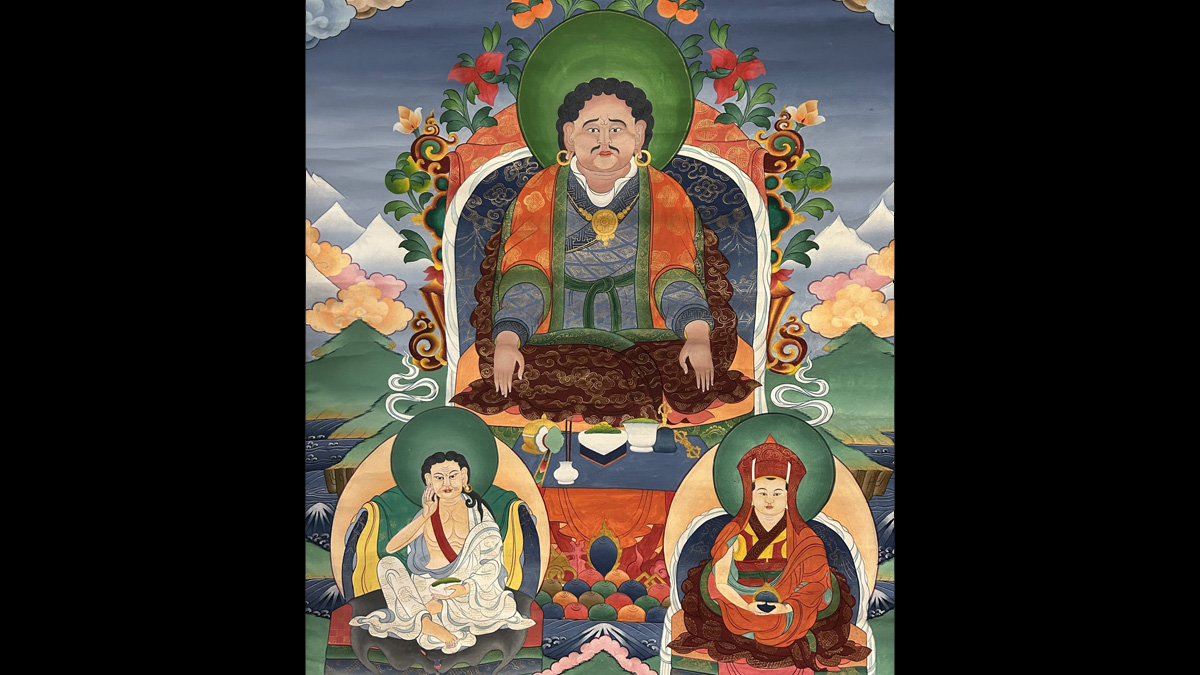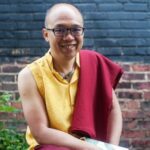The Six Dharmas of Naropa are a collection of practices of the unexcelled, or highest, class of yoga tantras (niruttarayoga tantra). As completion-stage practices, they involve the dissolution of a practitioner’s visualization of and identification with a deity into the realization of luminous emptiness. These practices began in India around the eleventh-century, and survive as a living tradition to this day in Tibetan-Himalayan Buddhism. As the name suggests, this particular collection of practices is most closely identified with the Indian mahasiddha Naropa, who is said to have received them from his guru, Tilopa.
Although Naropa’s legacy entered Tibet in several streams of transmission through a number of important teachers, Marpa of Lhodrak’s transmission of the Six Dharmas of Naropa is most well-known, due to the continued importance of these practices among Marpa’s Dakpo Kagyu spiritual descendants via Milarepa and Gampopa of Dakpo. This group of spiritual giants—Tilopa, Naropa, Marpa, Milarepa, and Gampopa—constitute the early masters of the Kagyu Lineage. And from Gampopa come the many lineages of the Dakpo Kagyu, with the Kamtsang, Drukpa, Drikung, and Taklung as those that continue as distinct lineages today. The Geluk lineage also engages in completion-stage practices of the Six Dharmas of Naropa, ever since its fourteenth-century founder, Tsongkhapa, received this set of transmissions from the Drikung Kagyu via the Zhalu-Sakya lineage. Tsongkhapa’s influential writings on this subject consider Pakmodrupa and his disciple Drikung Jikten Sumgon as the foremost authorities on the Six Dharmas of Naropa.
Although known as the Six Dharmas, it is very clear that this popular set of practices included more than six, taught in key, unexcelled yoga tantras such as the Hevajra, Cakrasamvara, Guhyasamaja, Catuhpita, and Kalacakra. While these practices originated in India and were taught by Naropa to Marpa, we have no Indian witnesses to the origin of the moniker, “The Six Dharmas of Naropa.” Recent research suggests that this designation may have originated with Gampopa, as one of the earliest occurrences of this name is found in his famous composition, The Jewel Ornament of Liberation.
Gampopa’s “Collected Works” includes a section on these yogas, and the list of six found there are: 1) inner heat, 2) radiance, 3) dream, 4) illusory body, 5) transference, and 6) intermediate state. Those who have mastered the creation-stage of deity yoga would begin training in these practices—these completion-stage yogas “complete” deity yoga, resulting in the realization of Mahamudra. For Gampopa, however, these completion-stage practices represent methods of enhancing the realization of Mahamudra. For Gampopa, Mahamudra attainment wasn’t exclusive to Vajrayana. While others considered the Six Dharmas as necessary for the realization of Mahamudra, Gampopa considered them as expedient methods to realizing Mahamudra, and he taught Mahamudra to disciples who focused on the Vajrayana, and thus the Six Dharmas, as well as to those who did not. Gampopa’s grand-disciple, Drikung Jikten Sumgon, wrote, “Devotion alone is the method that gives rise to realization.” In the Dakpo Kagyu, devotion is the underlying attribute that all Mahamudra practitioners need. Even the Six Dharmas of Naropa are powerless if devotion is lacking. Let’s take a look at a quote from Marpa:
Inner-heat is the path’s life-tree.
Transference is the path’s thought-cutter.
Intermediate state is the path’s welcome.
Dream is the path’s measure.
Radiance is the path’s essence.
Body-entering is the path’s assistance.
It is worth noting that these verses outline a slightly different version of The Six: 1) inner-heat, 2) transference, 3) intermediate state, 4) dream, 5) radiance, and 6) body-entering. Gampopa’s list replaces Marpa’s “body entering” with “illusory body,” as the transmission of the practice of “body-entering” was lost when Marpa’s son and heir to this practice, Darma Dode, died without transmitting it to anyone. In its place, Gampopa placed “illusory body,” and Gampopa’s six represent the most common list practiced by contemporary Kagyu and Geluk practitioners. While body-entering wasn’t unknown to Gampopa—he included instructions on that subject in his Collected Works — all current traditions of the Six Dharmas omit this practice.
In Kagyu lore, the Indian master Tilopa is identified as its first human lineage master, having received direct transmissions of the core Kagyu practices from the primordial buddha, Vajradhara. Nonetheless, Tilopa did have human teachers who imparted to him a set of practices known as “The Four Transmissions.” Like the varying contents of the Six Dharmas of Naropa, it is unclear which specific practices are included in the Four Transmissions and who imparted them to Tilopa. Most lists of the Four Transmissions include illusory body, dream, radiance, and inner heat — practices central to the Six Dharmas. The masters who taught Tilopa include Krishnacharya, Nagarjuna, Lavapa, and the female master Sukhasiddhi. According to Gampopa, Tilopa mastered these completion-stage practices and, in turn, gave them to Naropa. The rest of the transmission to Tibet is quite well known. Individually and collectively, all are part of lineages of masters and students who have transmitted the practices of the Six Dharmas from generation to generation.

